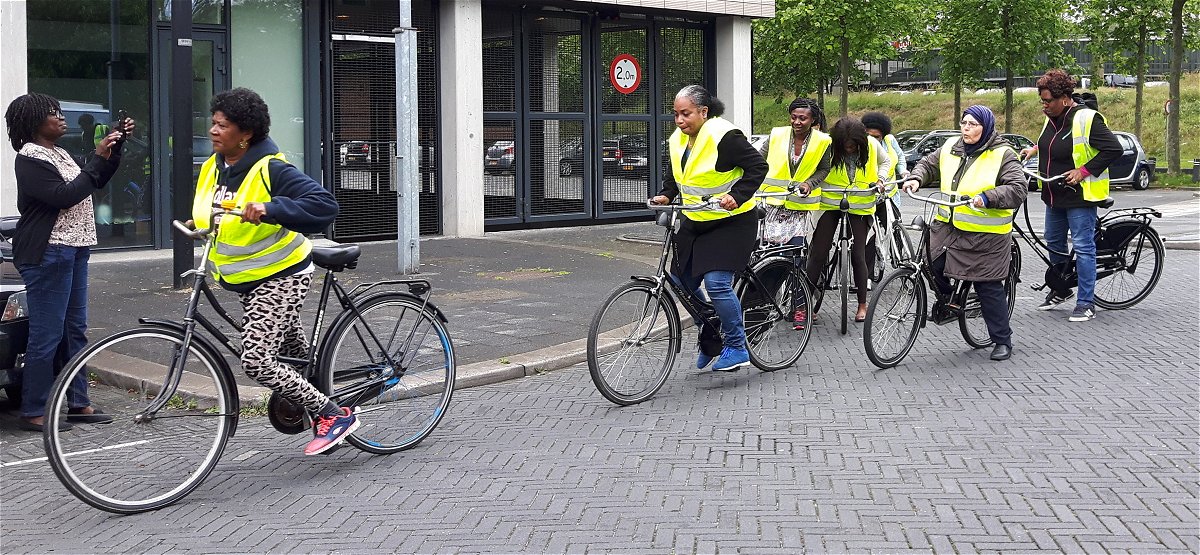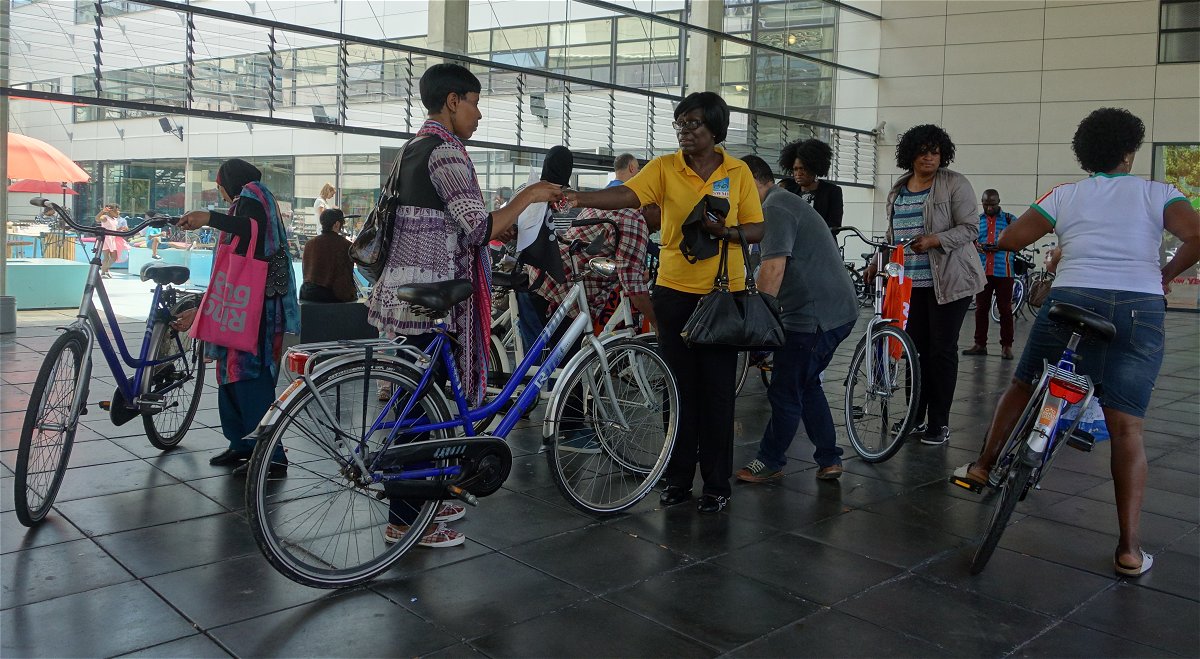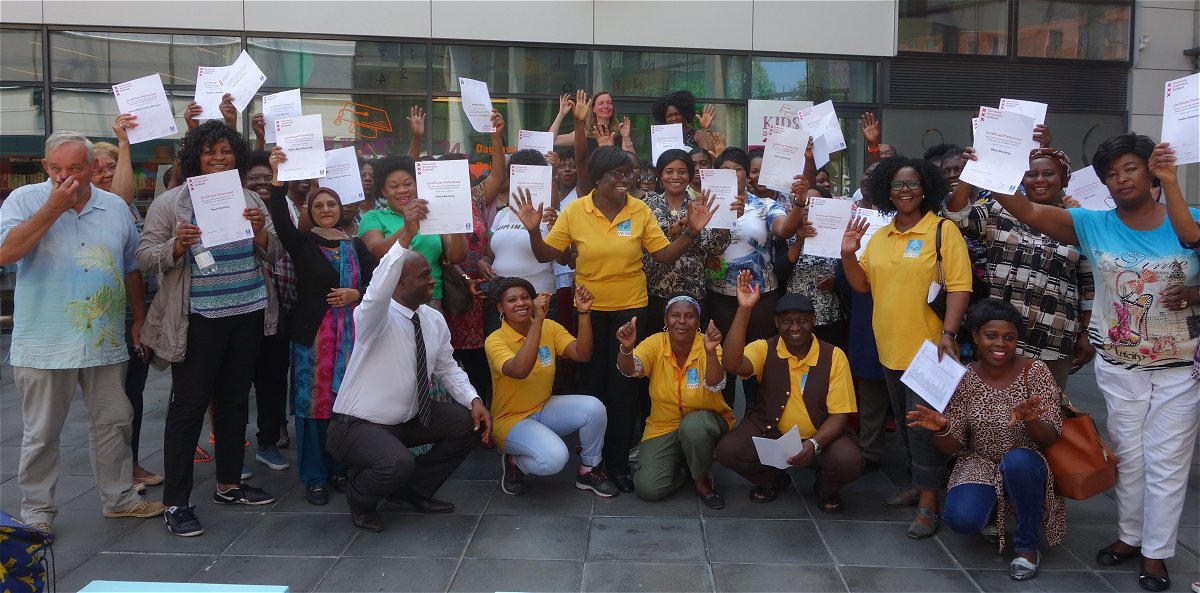Ventriloquism and cycling
Michael Tahmoressi (University of Minnesota, the College of Liberal Arts, Minneapolis, MN, US – tahmo004@umn.edu) reports for Favas.net on his pilot research about accessibility of cycling for non-western immigrants in the Netherlands. He applies ventriloquism as a communication metaphor, which ‘explains how the built environment of a transportation system and someone’s vehicle of choice can be made to speak.’
Introduction: Understanding communication is central to transportation planning and research.
This post will discuss how communication is central to non-western immigrants’ decision to cycle in the Netherlands. Specifically, how immigrants build a relationship with cycling which then grants them a deeper understanding of the place where they live. The cycle is an ubiquitous, cheap and reliable means of transportation in the Netherlands. However, I think it is disingenuous to say that cycling is just a mode of transport. This may be true for the native born Dutch population who have cycled their whole lives. Non-western immigrants use cycling as a vital tool to make life possible in their new home. This post will provide a glimpse into how non-western immigrants interpret cycling through discussing a theme that came up in qualitative interview research I conducted last fall (2022). First, I want to “set the scene” by describing who is a non-western immigrant in the Netherlands, and how their transportation choice has been characterized by urban planning professionals. The post will finish with a discussion of how planners can think about communication as a variable when building infrastructure and developing space for communities.

‘Mama Agatha’ Frimpong (left, with camera), runs her own cycling school for immigrant women at the Motivation and Integration foundation which she founded in Amsterdam. (Image: Favas.net)
Part 1: Who are non-western populations in the Netherlands and how much do they cycle?
Dutch people can be of a variety of ethnic backgrounds. But, the statistics show that there is a correlation between economic outcomes and someone’s ethnicity in the Netherlands. The Countries Bureau of Statistics claims that 75 percent of the Dutch population is of German and Celtic heritage (CBS, staff , 2021). The largest ethnic minorities are Moroccan who make up 2.4 percent of the population (CBS NL StatLine, 2022), and similarly Turks (including Kurds) 2.4 percent. Followed by Indonesians who are 2 percent (CBS staff 1, 2021). People of Surinamese descent also make up 2 percent. Folks from the Antilles or the citizens of Aruba and Curacao, make up less than 1 percent (CBS staff 1, 2021). Harms states these populations make up a tenth of the total Dutch population (Harms, 2006) 53% of the people who live in poverty are non-Germanic Dutch people (CBS staff 2, 2018). So what does this have to do with cycling research?
According to some cycling researchers, non-western immigrants do not cycle at the same rates as their western counterparts. The researchers’ opinions may not be representative of a true deficit in the non-western Dutch communities’ ability to cycle. Van der Kloof et al (2014) found that 25 percent of native born Dutch men utilized the bicycle as a daily mode of transport. 22 percent of non-western men utilized the bicycle as a mode of transportation (Van der Kloof, 2014). 29 percent of native born Dutch women utilize the cycle for daily transport.19.9 percent of non-western women utilize the bicycle for transportation (Van der Kloof, 2014). These statistics are old and could certainly use an update! Van der Kloof and Harms (2006) both describe cultural gaps as the reason why these immigrants do not cycle at the same rate. One example they provide is that these populations have an affinity for car ownership as a status symbol (Harms, 2006) In reality, there are cultural barriers to getting good data about these populations. I have colleagues interested in inclusive mobility and transportation. They have told me, that these non-western immigrants mis-trust the intentions of white European academics. The immigrants don’t like that the academics come into their communities to study them, without providing anything of value to the community. In turn, the immigrants are less likely to answer truthfully or provide data at all to the academics.
My project is interested in the non-western immigrant population’s qualitative experience, how through cycling they construct identities and meaning about their new homes. This project’s impact is to develop how urban planners and cycling researchers understand why people change behaviors to shift towards a sustainable alternative. I believe that my positionality will allow me to develop relationships with non-western immigrant populations which has been difficult for European researchers. I am a indigenous North American scholar whose ethnic origins are split between the Tarscano Tribe from Michoacan, Mexico on my mother’s side and Kurdish/Iranian on my father’s side. My positionality informs my approach to research. I am a public engagement centered researcher. Who is deeply motivated to collaborate with communities centered in my research. I am interested in how they communicate with their environments through the action of cycling. I utilize qualitative methods because it allows a great depth of understanding people’s feelings and experiences. This post will provide a sample of a theme from my initial qualitative data collection. Afterwards, I will provide some implications for why urban planning professionals and cycling researchers need to grapple with transportation behaviors as a form of communication.
Part 2: Accessibility of cycling for non-western immigrants.
My pilot research uncovered accessibility as a salient theme for participants. Accessibility to my participants was conducting vital actions for one’s life easily by bicycle. This could include trips to get groceries or other errands, commuting, or simply recreation. Last November I conducted three semi structured conversational interviews. My participants were young people between 25-35 who recently arrived in the Netherlands from non-western countries. My participants described how they had to develop their relationship to cycling before they reaped the benefits of accessibility. Cycling began to organize their daily life. Meryam, who is from a middle eastern country where women are not allowed to cycle. She did not think she would be a cyclist upon arriving in the Netherlands, because of having to deal with cycling during the rain. However once she reaped the benefits of accessibility, her mindset shifted about transportation.
Meryam: Yeah, you’re right if I want to connect (cycling) to what my background is. I just came here when I was in my mid-twenties. Before I didn’t have that many opportunities to cycle. When I came here, I just found it very interesting. I can exercise as much as I can even in my daily commute. It’s cheap, it’s whatever, that is my first intention, that I choose a bike over everything. Now I just keep it and I am not buying a car yet because I don’t feel the need to. Maybe it’s the closeness of cities and public transportation in between cities and also the cost benefit of it. However I have a lot of other friends who are immigrants who are resistant to bikes. Because, for example, they aren’t used to biking in the rain. Dutch people don’t care. It’s just normal rain. Maybe in my identity or culture I don’t like getting wet. This is something I get used to. I think I changed my way of thinking, well, it’s personality wise.
My participants had to partake in a communicative process to learn the benefits of cycling. The communication they undertook was primarily with non-human entities; their bicycles and their cities’ infrastructure. For native born Dutch people cycling is “a national habitus” (Kuipers, 2012). In this context a habitus is a behavior that has been developed through a coordinated effort between government authorities, transportation planners, and activists and finally adopted by the general population (Kuipers, 2012). My participants did not attend cycling schools or receive formal communication about cycling in the Netherlands. They are cultural newcomers who developed a language to understand cycling in the Netherlands. Pranav, a participant, described cycling as “the Dutch way of mobility”. Meryam accepted being rained on while cycling. In exchange, she saved money on transportation by not owning a car or being entirely reliant on public transportation. Her decision translated to easing the burden of transitioning to life in a new country. Her perspective pushes back on the deficit thinking of Van der Kloof (2014) and Harms (2006) that non-western immigrants are fixated on car ownership as a status symbol. All three of my participants viewed car ownership as an unnecessary, onerous financial burden. They preferred taking public transportation for long trips and cycling in their cities.
My participants’ choice to cycle granted them greater accessibility to where they lived. In turn, their perception of how they related with that environment was impacted by cycling. This is an example of why transportation is intimately tied to communication without explicitly written or spoken words doing the communicating. Wayfinding is an example of this non-verbal communication. Liu Kang, a PhD student from an East Asian country, described how the cycle provided him with a visual understanding of how to wayfind through the area where he lives.
Michael: Okay. So when thinking about where you live, though. Does cycling make you feel connected to the place where you’re living?
Liu Kang: Yes.
Michael: Why would you say that?Liu Kang: I think with cycling I can be more familiar with a place. I think that’s the main way.
Michael: Does it make you feel more connected to The Netherlands?
Liu Kang: Yes, I totally agree with that, because I also take a train. But not quite a lot. When I take the train from where I live to where I work. Actually, I only know the train stations in both cities, so I hardly know anything in between them. Well, when I cycle, I know. Okay, so along this route, I know which neighborhood is good, which neighborhood is bad, where the forests and the parks are. I know the intersections and which ones are traffic controlled. So I know everything along my route.
Liu’s wayfinding is active. He is able to remember elements of his city, like parks or specific neighborhoods that mark the progress to his destination. Whereas to the participant, public transportation is a passive form of wayfinding. The only elements known to the rider are the stop they get off and on. Meryam’s flexibility to adopt a new cultural way of understanding transportation and Liu’s approach to wayfinding demonstrates how bicycling for transportation is a relational practice where the rider communicates with the environment they cycle through.

‘Mama Agatha’ Frimpong (yellow cycling shirt), busy at het cycling school for immigrant women. (Image: Favas.net)
Part 3: Intervention-transportation as a Ventriloquial approach, how roads and vehicles communicate through humans.
I am trained as an environmental and organizational communication scholar. In my discipline cycling has been theorized to produce a ventriloquial effect on the cyclist. Communication scholars have utilized ventriloquism, the art (where a dummy appears to be talking, yet a human is talking for them) as a metaphor that explains how communication operates in contexts where non-human entities are made to speak. This type of communication is either ventriloquized through people or it ventriloquizes people. People ventriloquize social ideas when they enact culturally situated behaviors. An example is how my participants continued cycling because of the accessibility it provided them. People are ventriloquized when their practice of a dominant cultural behavior reinforces that behavior. An example of this is “car brain” in the United States. Drivers with “car brain” become adversarial to pedestrians and transit riders. Here is a definition of the ventriloquial approach by Dr. Ziyu Long, an organizational communication scholar.
“The ventriloquial approach showcases how “human interactants [usually operating as ‘the ventriloquist’] position themselves (or are positioned) as being constrained or animated by different principles, values, interests, (aspects of) ideologies, norms, or experiences, which operate as ‘figures’ that are made to speak to accomplish particular goals or serve particular interests” (Long, 2016, p. 426)
Long’s definition of the ventriloquial approach explains how communication works between people and non-human entities. Non-human entities are made to speak through human interpretation and action. Communication research has examined how ventriloquial interpretation exists in the context of cycling as a commuting behavior. Wilhoit and Kisselburgh (2019) explored how cyclists self-identify as minorities on US roadways. Their research provides two reasons why the dominant modes available in a transportation environment ventriloquize commuter behavior. First, is that dominant and alternative practices, people, and objects exist in relation to each other, and it is through their contrasting relationship that behaviors either seem normal or abnormal (Wilhoit and Kisselburgh, 2019). Second, the relationship between practices and people is ventriloquized or made to speak so that the contrast between activities foregrounds the meaning of the normal practices and backgrounds the meaning of the abnormal practices (Wilhoit and Kisselburgh, 2019).
Ventriloquism as a communication metaphor, explains how the built environment of a transportation system and someone’s vehicle of choice can be made to speak. In the case of Wilhoit and Kisselburgh’s research cycling was the abnormal practice and car driving was the normative practice. Cycling in the Netherlands is normal behavior. A cyclist in this environment communicates with the silent machine of the bicycle and the transportation environment. These non-human elements are made to speak through a person’s relationship to cycling. Ventriloquism can be useful to understand how communication plays a role in explaining people’s transportation choices.
Urban planning professionals should consider how accessibility is a ventriloquial approach when designing infrastructure. How should they do this? First, they need to understand obstacles that impede newcomers to cycle. Meryam demonstrated how once she understood the benefits of cycling. She overcame dissatisfaction with being rained on. Planners may not be able to change the weather. However they can design environments like 15 minute neighborhoods to make active transportation more attractive to residents in that neighborhood. Building more inclusive communities can help newcomers to better ventriloquize a behavior like cycling. Second, planners should build systems of inclusive wayfinding. These systems would go beyond signs to include sensory environmental cues. Liu described how cycling allowed him to gain a better understanding of the physical environment of his new home.

‘Mama Agatha’ Frimpong (standing in the middle, yellow shirt), celebrating her pupil’s cycling certificates. (Image: Favas.net)
Conclusion: next steps for my research
My research explores ways that these immigrants ventriloquize cycling to make it a daily habit. Meryam’s related how there is still skepticism by her immigrant friends towards cycling because it violates their cultural understandings. The ventriloquial approach does not simply assimilate non-western immigrants into Dutch culture through cycling. Kuipers (2012) has articulated that cycling is no longer a coordinated cultural force in the Netherlands. The immigrants add additional texture to cycling as a cultural behavior. An example is visibly non-western immigrants such as Muslim women wearing hijabs on cycles. Next year (2024) I will be in the Netherlands for a year to conduct research for my first book. The research that will allow me to investigate from a larger pool of participants why they choose cycling. This research is valuable because it will provide qualitative context for researchers and urban planners who are interested in inclusive mobility issues.
References
Bicycle dutch. Bicycles for refugees, 2016. https://bicycledutch.wordpress.com/2016/07/19/bicycles-for-refugees/. Accessed on 29 jan, 2023.
CBS NL staff 1. (2021). Half of Refugee Households at risk of Poverty.
Online access https://www.cbs.nl/en-gb/news/2018/46/half-of-refugee-households-at-risk-of-poverty
CBS NL Staff 2 (2021). Population Dashboard. Central Bureau of Statistic Netherlands https://www.cbs.nl/en-gb/visualisations/dashboard-population
CBS NL StatLine (2022). https://opendata.cbs.nl/statline/#/CBS/nl/dataset/37325/table
Holland.com. ‘Mama Agatha’ gives cycling lessons, 2022, https://www.holland.com/global/tourism/travel-inspiration/bring-yourself/mama-agatha-gives-cycling-lessons.htm. Accessed 29 jan. 2023.
Kuipers, G. (2013). The rise and decline of national habitus: Dutch cycling culture and the shaping of national similarity. European Journal of Social Theory, 16(1), 17–35.
Ziyu Long (2016) A Feminist Ventriloquial Analysis of Hao Gongzuo (“Good
Work”): Politicizing Chinese Post-1980s Women’s Meanings of Work, Women’s Studies in
Communication, 39:4, 422-441, DOI: 10.1080/07491409.2016.1224991
Servas international. Asylum seekers cycle in Haarlem, 2022. https://servas.org/de/testimonials/asylum-seekers-cycle-haarlem. Accessed on 29 Jan. 2023.
Wilhoit E. D. & Kisselburgh L.G. (2019). The relational ontology of resistance: hybridity, ventriloquism and materiality in the production fo bike commuting as resistance. Organization. 26(6) 873-893
Van der Kloof, A., Bastiaanssen, J. & Mertens, K. (2014). BICYCLE LESSONS, ACTIVITY PARTICIPATION AND EMPOWERMENT. Radboud Repository, pp.1-17.
Acknowledgements
Text:
Michael Tahmoressi (University of Minnesota, the College of Liberal Arts, Minneapolis, MN, US), February 2023.
Contact: tahmo004@umn.edu
Images:
Rob van der Bijl (Favas.net / GoDutchCycling, Amsterdam, Netherlands), June-July 2016.
See also:
Favas.net (2019) https://favas.net/reports/cycling-mama-agatha-received-certificate/
Marek Jancovic (2015) with his documentary about Mama Agatha, which can be viewed at YouTube.

